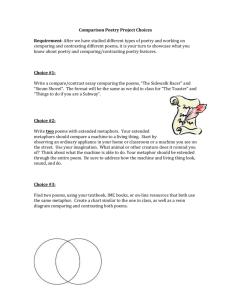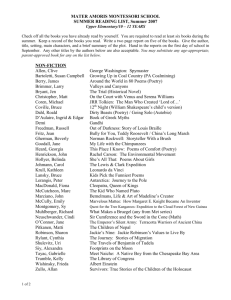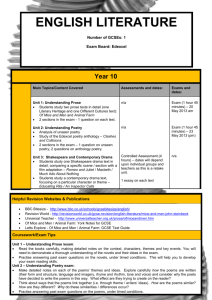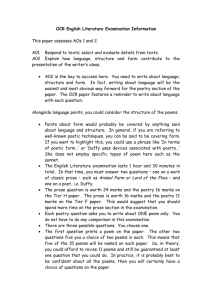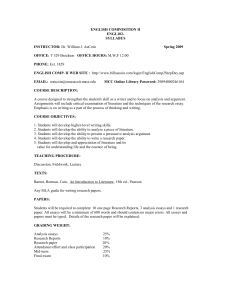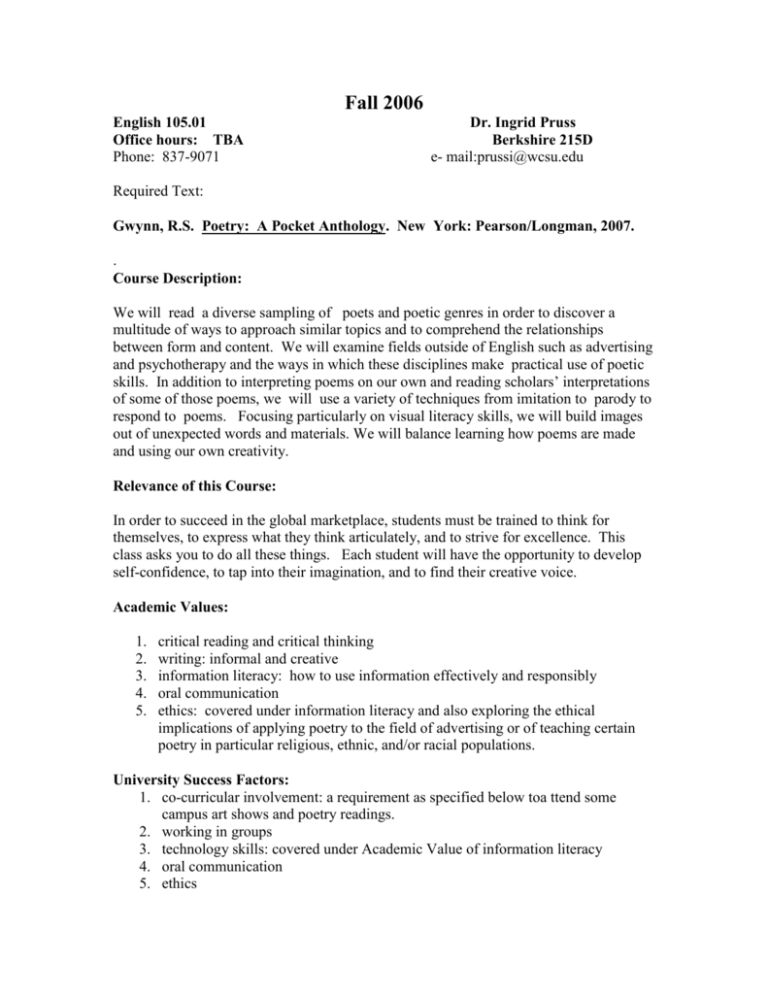
Fall 2006
English 105.01
Office hours: TBA
Phone: 837-9071
Dr. Ingrid Pruss
Berkshire 215D
e- mail:prussi@wcsu.edu
Required Text:
Gwynn, R.S. Poetry: A Pocket Anthology. New York: Pearson/Longman, 2007.
.
Course Description:
We will read a diverse sampling of poets and poetic genres in order to discover a
multitude of ways to approach similar topics and to comprehend the relationships
between form and content. We will examine fields outside of English such as advertising
and psychotherapy and the ways in which these disciplines make practical use of poetic
skills. In addition to interpreting poems on our own and reading scholars’ interpretations
of some of those poems, we will use a variety of techniques from imitation to parody to
respond to poems. Focusing particularly on visual literacy skills, we will build images
out of unexpected words and materials. We will balance learning how poems are made
and using our own creativity.
Relevance of this Course:
In order to succeed in the global marketplace, students must be trained to think for
themselves, to express what they think articulately, and to strive for excellence. This
class asks you to do all these things. Each student will have the opportunity to develop
self-confidence, to tap into their imagination, and to find their creative voice.
Academic Values:
1.
2.
3.
4.
5.
critical reading and critical thinking
writing: informal and creative
information literacy: how to use information effectively and responsibly
oral communication
ethics: covered under information literacy and also exploring the ethical
implications of applying poetry to the field of advertising or of teaching certain
poetry in particular religious, ethnic, and/or racial populations.
University Success Factors:
1. co-curricular involvement: a requirement as specified below toa ttend some
campus art shows and poetry readings.
2. working in groups
3. technology skills: covered under Academic Value of information literacy
4. oral communication
5. ethics
Course Requirements:
In class work (includes freewrites, mini- assignments, and journaling )
All work done in class will be collected in order to give students credit for it. In-class
work may not be made up. If you are absent, you simply lose credit for the work unless
you have a documented medical excuse for a severe illness or an emergency; if you have
such a circumstance, bring the note and see me during office hours.
Homework assignments
All homework assignments must be typed
Late homework is not accepted unless you can document a severe illness or emergency.
Two multimedia projects which combine images, sculpture, or video with original verbal
imagery.
Students must attend one art show and one poetry reading and type a one page response
to each.
Evaluation and Grading:
In-Class writing assignments and group work
35%
Homework
20%
Projects
40%
Attending poetry reading and art show and responding to each 5%
Classroom Etiquette:
1. Be on time to class (or even early!). Though the door will remain unlocked
for the first ten minutes of class, walking in late disrupts the learning process
and is simply rude and irresponsible.
2. If you walk in when class is in progress, walk behind the professor or
student who is presenting. Do not make noise or speak to your neighbor.
3. When another person is talking, do not speak to anyone. Listen! You will
learn something. If you think of something when someone else is speaking,
write yourself a note, and share it with the class later.
4. Turn off your cell phones before class begins. If you have a family
emergency, leave the phone on vibrate, and sit near the door in case you
have to take a call. Please do not use text messaging during class.
5. Since you want to be respected by all, you are required to respect all.
6. If you disagree with someone, please express your viewpoint, without
attacking the speaker. Avoid comments like “You don’t know what you’re
talking about,” or “ That’s stupid.” Instead, speak about the concept or idea
as you see it.
7. Leave all negativity outside the classroom door please.
8. Bring your own supplies to class (i.e., paper, pen, paper clips, stapler, etc).
9. Get interested in the material. Since we will be spending three hours per
week together, let’s make it an enjoyable experience.
10. If you are not well and/or if you are unable to stay awake, please stay home.
11. If you are absent, you are required to get the assignment(s) from a classmate.
Please do not email me or call me to request it. I suggest you get the phone
number of two students in the class; the worst that can happen is that you
make a new friend!
Honor Code:
All work turned in must be your own (not a friend’s, nor a former student’s, not a
website author’s). Using another person’s words or ideas without giving that
person/site credit constitutes plagiarism, which is the theft of intellectual property,
and will result in your failing this class.
Material to be covered:
I. Exploring Varied Forms
“Discovering My Daughter,” “I Wandered Lonely as a Cloud,” “Bilingual Sestina,”
“All-American Sestina,” “Daddy,” “Ulysses,” ”How Everything Happens,” “A
Poison Tree,” “The Chimney Sweeper,” “Coy Mistress,” “To His Coy Mistress,” “My
Last Duchess,” “ Porphyria’s Lover,” “A Valediction: Forbidding Mourning,”
“Paradelle for Susan,” “Alan Doll Rap,” “A Monorhyme for the Shower,” “Oh, oh, you
will be sorry for that word,” “When I have fears,” “ Shakespeare “Sonnets” (specifically
18, 73 , 129, 130), “Idea: Sonnet 61,” “Astrophel and Stella : Sonnet 1,” “Work Without
Hope,” “Redemption,” “Ozymandias,” “Do Not Go Gentle Into that Good Night,”
“Acquainted with the Night,” “She walks in Beauty,” “The Colonel,” “Crossing
Brooklyn Ferry.”
Objectives and Learning Outcomes
Students learn
1. The basics of poetic forms – lyrics, sonnets, sestinas, among others
2. The meaning and importance of iambic pentameter as a core rhythm
3. Different ways of approaching and interpreting poetry -- scholarly and creatively.
4. Oral and written ways of responding to individual poems and to groups of poems
5. The ways in which individual voice is highlighted even in fixed forms
6. The application of verbal reading strategies to the visual realm in art and
advertising.
7. Ways of using natural speech in poetry and how to compose their own dramatic
monologues
II. Comparing Poems Dealing with Similar Themes during Very Different Times
and/or Using Very Different Strategies:
“Domestic Work, 1937” “homage to my hips,” “Stamp Collecting,” “The Traveling
Onion,” “The Latin Deli: An Ars Poetica,” “Combing,” “The Serenity in Stones,” “My
Husband Discovers Poetry,” “Dim Lady,” “ My Mistress’ Eyes Are Nothing Like the
Sun,” “Litany,” “Bestiary,” “The Book,” “The Sacred” “The Black Walnut Tree,”
“Diving into the Wreck,” “September Twelfth, 2001,” “Saint Judas,” “American
Classic,” “Paradoxes and Oxymorons,” “Digging,” “Mementos I,” “Subterfuge,” “The
Ache of Marriage,” “The Canonization,” “Love Song: I and Thou,” “Love (III),” “In
This Strange Labyrinth How Shall I Turn,” “Aunt Jennifer’s Tigers,” “The Heaven of
Animals,” “The Death of the Ball Turret Gunner,” “the mother,” “On My First Son,” “
“Traveling Through the Dark,” “Root Cellar,” “A Supermarket in California,” “The
New Colossus,” “ In a Station of the Metro,” “ Theme for English B” “Song of Myself”
(164-172), “Journey of the Magi,” “The Second Coming.”
Objectives and Learning Outcomes
Students learn
1.
2.
3.
4.
5.
To articulate the central insights of individual poems
To compare poems with similar insights written in different time periods
To organize and articulate similarities and differences among poems
To differentiate between subject matter and theme
To examine and to discuss sensitive social, intellectual, emotional, ethnic,
religious, and ethical issues which the poetry raises.
6. To find visual images to discuss in relationship to a poem in this unit, and to
explain their thoughts on that relationship orally and in written form
III. Repetition is Never Just Repetition:
“ She Had Some Horses,” “The Raven,” “Narcissus and Echo,” “Approaching a
Significant Birthday, He Peruses and Anthology of Poetry,” “Facing it,” “Women
Bathing at Bergen-Belsen,” “Siren Song,” “What’s That Smell in the Kitchen?”
“Cinderella,” “How Everything Happens,” “We Real Cool,” “Those Winter Sundays,”
“Sonnets from the Portuguese -- 43,” “One Art,” “Dolor,” “Silence,” “Much Madness
is Divinest Sense,” “There is a Garden in Her Face”
Viewing and discussion of Eve Ensler’s film What I want my words to do to you
Objectives and Learning Outcomes
Students learn
1.
2.
3.
4.
To comprehend how refrains and repetition works in poetry.
To understand how context changes the meaning of repeated words
To use visual media to concretize their understanding of this unit
To create their own poetic examples which illustrate their understanding of this
unit
5. To discuss the therapeutic uses of poetry
IV. Uncategorized:
“Tell all the truth but tell it slant,” “The Last Words of My English Grandmother,”
“Anecdote of the Jar,” “Home Burial,” “The Trees in the Garden Rained Flowers,”
“God’s Grandeur,” “Pied Beauty,” “Kubla Khan,” “The Flea”
Objective and Learning Outcomes
Students learn
1.
2.
3.
4.
To find different ways to contextualize these poems
To practice their critical insights in interpreting poems
To construct images in the styles of Dickinson, Hopkins, and Donne
To find examples of poetry on the internet that use the same strategies



